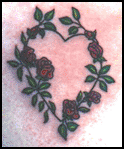| VOLUME 32, NUMBER 6 | THURSDAY, September 28, 2000 |
By JENNIFER LEWANDOWSKI
"Make sure the facility you choose to go to looks like your dentist's office-in terms of cleanliness," Snyder, who works in the Student Health Center, told those attending a recent Life Workshop session on "Tattoos and Body Piercing 101."
"Body piercings can be removed-tattoos cannot," she stressed, reminding students that should the time come to, for example, join corporate America, an eyebrow ring can be removed much more easily than a tattoo in a conspicuous place.
Snyder said she first became interested in body piercing when she arrived at the university in 1994.
"I experienced a patient who had an infected umbilical ring and I didn't know how to treat (the patient)," she said. As a result of that encounter, Snyder took an active interest in body piercing, researching its history and current trends.
Although it may seem a fairly new trend, body piercing is really a lost art, Snyder explained.
"None of these arts are new-they've been revived," she said of both body piercing and tattooing. While body piercing was brought into vogue around 1979 in San Francisco, its roots stretch back much further.
Ancient Egyptians pierced their navels, as well as the Mayans and Aztecs, who also pierced their noses and lips, Snyder said. Nipple piercing was believed to be popular among the Roman Centurians-specifically to support the capes worn in that time-Snyder said.
History aside, Snyder concentrated on aiding students in making informed decisions about where to go and how to care for piercings and tattoos.
She suggested that for those considering getting pierced, touring area salons first is the most reasoned approach.
"Visit salons, and not in an altered state of mind," she quipped. "There should not be any opposition to looking in the back (where the piercing takes place) and asking about cleanliness."
Further, autoclave sterilization of the instruments involved in the piercing process is a must, and a good piercer will not make a move without first asking for proper identification, as a person must be older than age 18 to get pierced, Snyder said. Piercers always should wear new latex gloves for each client, and above all, needles should be sterile and disposed of after each use, she said.
Since there are virtually no requirements in place in the United States for an individual to become trained as a professional body piercer, researching salons is a must.
"You really need to be a smart consumer, here," Snyder said, adding that in the case of tattoo artists, a certificate is required. In Erie County, tattoo artists' certificates are renewed each year after a visit from the county Department of Health.
"(They) need to demonstrate they know the code for safety," she explained, adding that it's important to realize that safety compliance is not reflective of talent.
"The certification does not tell you anything about their skill level," she advised, noting that individuals interested in getting a tattoo should ask to see a book of the artist's work.
As for the do-it-yourself method, Snyder strongly warned against it, as inexperienced piercers risk nerve damage and psychological trauma.
In addition, salons use special, larger-gauge needles through which the jewelry is threaded into the desired area, and the use of improperly sized needles can result in eventual closure of the hole. Snyder said a piercing gun should never be used, save on the ear lobe, as a gun can damage cartilage and cannot be sterilized.
The Hepatitis B virus-the greatest infectious risk of piercing-is likely to be transmitted with a piercing gun or through "something used by the piercer that has been used before," since the virus "can be spread by minute amounts of blood," she said.
She also stressed the importance of using appropriate jewelry. Surgical stainless steel, 14-karat or 18-karat solid gold, titanium or niobium are the only suitable metals for piercing, she said.
Infection is common with piercings, given the invasive nature of the procedure, said Snyder, who emphasized the need for proper care.
Piercings should be treated with warm water, antibacterial soap or, in the case of the tongue, an antimicrobial alcohol-free rinse, and should be rotated during the cleaning process.
If signs of irritation, such as redness, swelling, pain and discharge, persist after the appropriate healing time-which varies with each type of piercing-Snyder recommended increased cleaning as the first step.
The next course of action, she said, would be to visit a physician.
Keloids, or scar tissue formations, also are common with piercings, Snyder said. But the problem with keloids, is that once formed, they continue to grow in size.
"If they're still soft, they can be injected with cortisone to break up the tissue, but usually you have to have (the keloid) surgically removed," she said.
While the body may be forgiving of such procedures, society isn't always.
"Unfortunately, society is not all that accepting of tattoos and piercings," she said, which is why taking time to research and reason body art is necessary before doing the deed, especially in the case of tattoos, which-save painful, lengthy and costly procedures to remove them-are forever.
Front Page | Top Stories | Photos | Briefly | Q&A | Electronic Highways
UB physician offers advice to Life Workshop participants on piercing, tattoos
Reporter Contributor Her second rule of thumb was reminiscent of the familiar adage, "Look before you leap."
Her second rule of thumb was reminiscent of the familiar adage, "Look before you leap."
Exhibits, Jobs, Notices | Sports | Events | Current Issue | Comments?
Archives | Search | UB Home | UB News Services | UB Today
